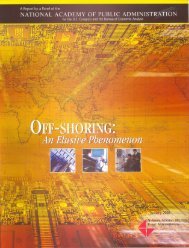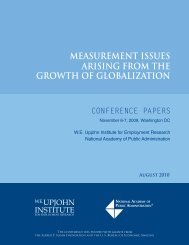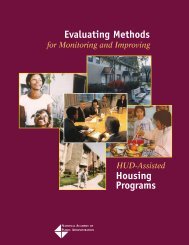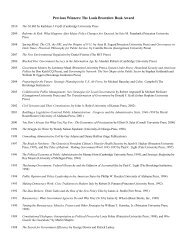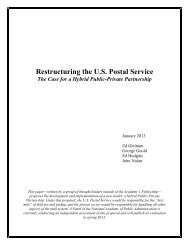High-Performance Partnerships - National Academy of Public ...
High-Performance Partnerships - National Academy of Public ...
High-Performance Partnerships - National Academy of Public ...
Create successful ePaper yourself
Turn your PDF publications into a flip-book with our unique Google optimized e-Paper software.
PARTNERSHIP CASE STUDIES<br />
chapter three<br />
The partnership asked workplace intermediary<br />
organizations to distribute caregiver materials<br />
or post the materials on their respective websites.<br />
These organizations have huge memberships,<br />
which extend the partnership’s reach.<br />
They included the <strong>National</strong> Federation <strong>of</strong><br />
Independent Businesses with 607,000 members,<br />
Small Business Administration with access to<br />
one million businesses, Society for Human<br />
Resources Management with 165,000 members,<br />
and Washington Business Group on Health representing<br />
174 <strong>of</strong> the nation’s largest employers.<br />
CMS developed relationships with the public,<br />
voluntary, and private sectors to seek partners.<br />
Employers and workplace intermediaries were<br />
motivated to partner with CMS because they<br />
saw the advantage <strong>of</strong> educating employed caregivers.<br />
Doing so would reduce the time that the<br />
employed caregiver would be preoccupied, leading<br />
to an increase in productivity. Caregiver<br />
organizations were motivated to help by virtue<br />
<strong>of</strong> their mission, while beneficiary advocacy<br />
organizations were energized by their goal <strong>of</strong><br />
helping the target audience <strong>of</strong> beneficiaries<br />
through caregivers. CMS has large, mid-size,<br />
and small employer involvement. The motivations<br />
were diverse but the goal was universal.<br />
There were no formal agreements, exchange <strong>of</strong><br />
funds, or solicitations. The major resources<br />
were pr<strong>of</strong>essional caregiver expertise, access to<br />
worksites, and access to workplace intermediaries<br />
and employed caregivers. The caregiver<br />
organizations provided expertise, credibility<br />
for promoting partnership products, and<br />
tremendous reach and penetration in other<br />
related organizations and audiences. The partnership<br />
had a “swap <strong>of</strong> assets.” The strategic<br />
plan was the work <strong>of</strong> the CMS Caregiver<br />
Workgroup. Once developed, the partners<br />
identified other organizations that might partner<br />
for various reasons. One example was the<br />
Work Family Network <strong>of</strong> Maryland, a group <strong>of</strong><br />
15 employers in the DC-Baltimore area concerned<br />
with their employees’ work and family<br />
issues. It helped with developing materials<br />
and providing employed caregivers for focus<br />
group testing.<br />
The partners defined their roles and responsibilities<br />
along three categories: develop the<br />
materials, test them, and distribute them.<br />
The partners came to the table to perform a<br />
specific function—help develop and distribute<br />
materials, post them on websites, provide<br />
caregivers for focus groups, make employer<br />
clients available for pilot tests, comment on<br />
materials, provide organizational logos as<br />
endorsement and legitimacy, and suggest<br />
ways to increase distribution. As the<br />
60 Powering the Future: <strong>High</strong>-<strong>Performance</strong> <strong>Partnerships</strong>




